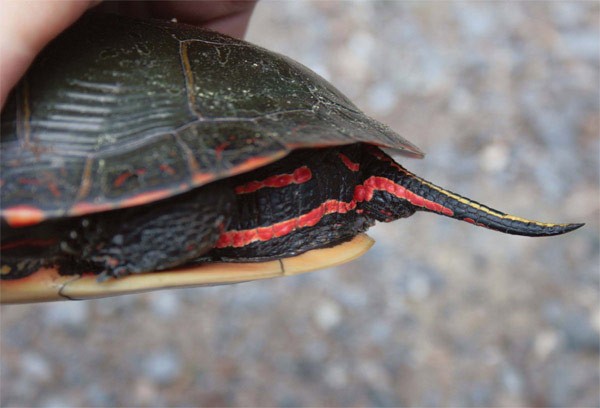As northerners, our turtles must contend with frigid winters. Unable to maintain the necessary body temperature to carry out essential metabolic activities, a turtle settles down into the mud for a long winter’s sleep. Its heart rate slows to almost nothing, and its organ systems more or less shut down.
Finding food is not a problem – like all hibernators, a turtle lives on the rich body fat that was stored in the previous summer’s season of plenty. But finding oxygen with which to metabolize this fat is a challenge. Unlike a terrestrial hibernator, a turtle winters in an oxygen deficient environment for four or five months. When fat is metabolized in the absence of oxygen, the process creates lactic acid, and when too much of this acid builds up, the resulting condition – known as acidosis – can be fatal to an animal.
A pond turtle finds a remedy to this problem in its shell and skeleton, which together account for over a third of the animal’s weight. The shell of a turtle is not just for protection – being heavy, it also helps with buoyancy control by counteracting the air-filled lungs and it acts as a hydrofoil when the animal swims.
For hibernating turtles, the shell is also vitally important in a chemical sense. Just as we take buffering tablets, like Tums, to relieve an acid stomach, a hibernating turtle uses its shell and bone, composed of limy compounds, to release carbonates into its increasingly acidic body fluids. This buffers the acid build-up in a nonbreathing turtle, when it snoozes down in the oxygenless mud of a winter pond, and deadly acidosis in the animal’s tissues is prevented. Furthermore, the shell stores accumulations of this buffered lactic acid where it can do no harm.
In effect, a hibernating turtle is a closed system independent of the environment, an extraordinary feat of biochemical juggling that allows metabolism to continue throughout winter.
But wait. There’s more.
All reptiles (also amphibians and birds) have a sizeable rear opening called a cloaca. It is a common, muscular chamber into which the rectum, urinary, and reproductive systems empty. It serves as a mating and egg-laying opening, as well as one through which urinary and digestive wastes are excreted. It’s a good design that has served these animals well for millions of years.
The cloaca in some kinds of freshwater turtles, such as our eastern painted turtle, has fingerlike extensions that are abundantly supplied with blood vessels. The muscular walls of the cloaca contract and relax, forcing water in and out of the chamber. If a painted turtle hibernates in a pond where some dissolved oxygen is available, the cloaca will serve as a respiratory device. As a substitute “lung,” the cloaca allows for the transfer of oxygen and carbon dioxide between the animal and the surrounding water.
Only certain turtles have this ability, but those that do carry on oxygenfueled metabolism under low-oxygen conditions. The world champion is an Australian river turtle that breathes through its rear end almost all the time. It’s a “bum breather,” as the Aussies say.



Discussion *